“Taking your seat at the table doesn’t work so well, I thought, when no one wants you there.”
These words from investor and business executive Ellen Pao, who unsuccessfully sued former employer Kleiner Perkins for gender discrimination, no doubt resonate with many women struggling for recognition in corporate America.
[The data in this blog was pulled in January 2020, before COVID-19 created drastic changes in employment—especially for women. To understand how COVID-19 impacted women in industries ranging from retail to healthcare check out, Women on the frontlines of the pandemic.]
Although some companies do well elevating women to leadership positions—particularly in certain industries or at businesses of a certain size—new data from ZoomInfo suggest that the rate at which females are promoted to management and executive levels still pales in comparison to their male counterparts.
Outside factors are helping women succeed more, such as California’s new law that requires at least one woman on the board of each public company headquartered in the state.
Men Disproportionately Promoted Over Women, With a Few Caveats
Across the United States, women comprise 47% of the workforce, as noted in U.S. labor statistics. While women make up 40% of managers at companies, only 20% reach the top spot of CEO, according to ZoomInfo’s analysis of 60 million professionals in its database.
Those figures indicate a lower promotion rate for women compared to their male colleagues: For every three men promoted to managers, only two women get similar promotions, and only one woman gets the nod for CEO for every four men.
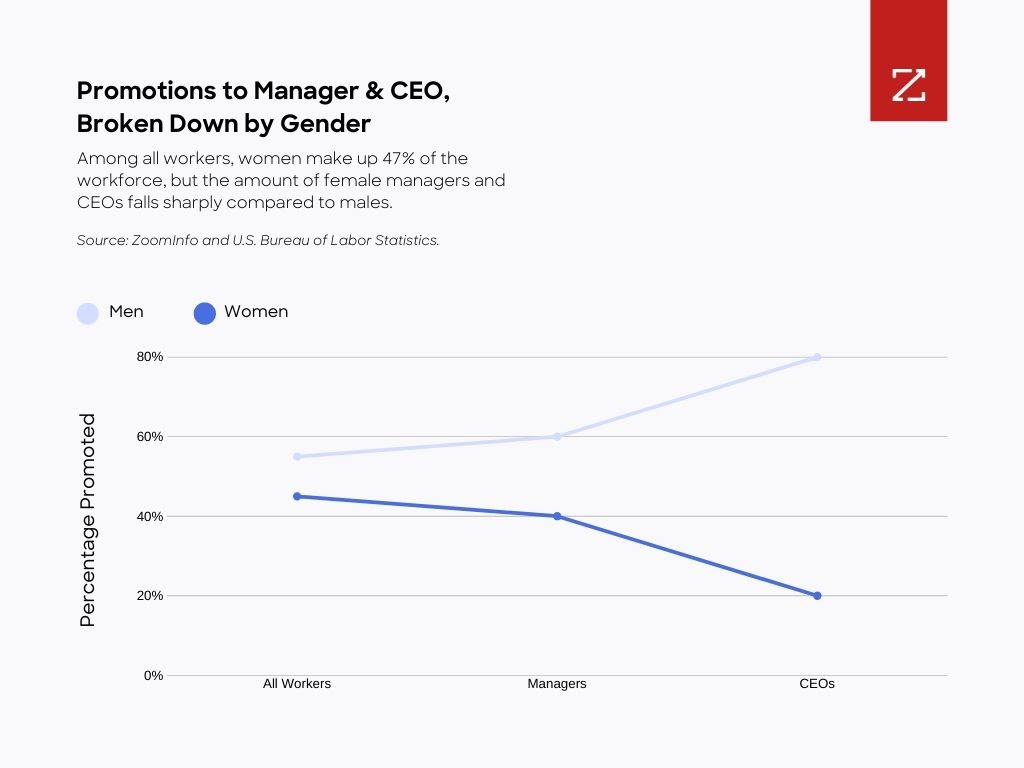
“Between the genders, males are more likely to get a promotion compared with females—9.3% percent compared with 8.4% percent, respectively,” payroll software provider ADP noted in a 2019 workforce study.
Promotion of Women Varies Dramatically by Industry
The promotion rate of women varies widely by industry. For example, in nonprofit organizations women make up 56% of the workforce and 41% of the CEOs, while in the insurance industry, women make up 55% of the workforce but only 15% of CEOs are female.
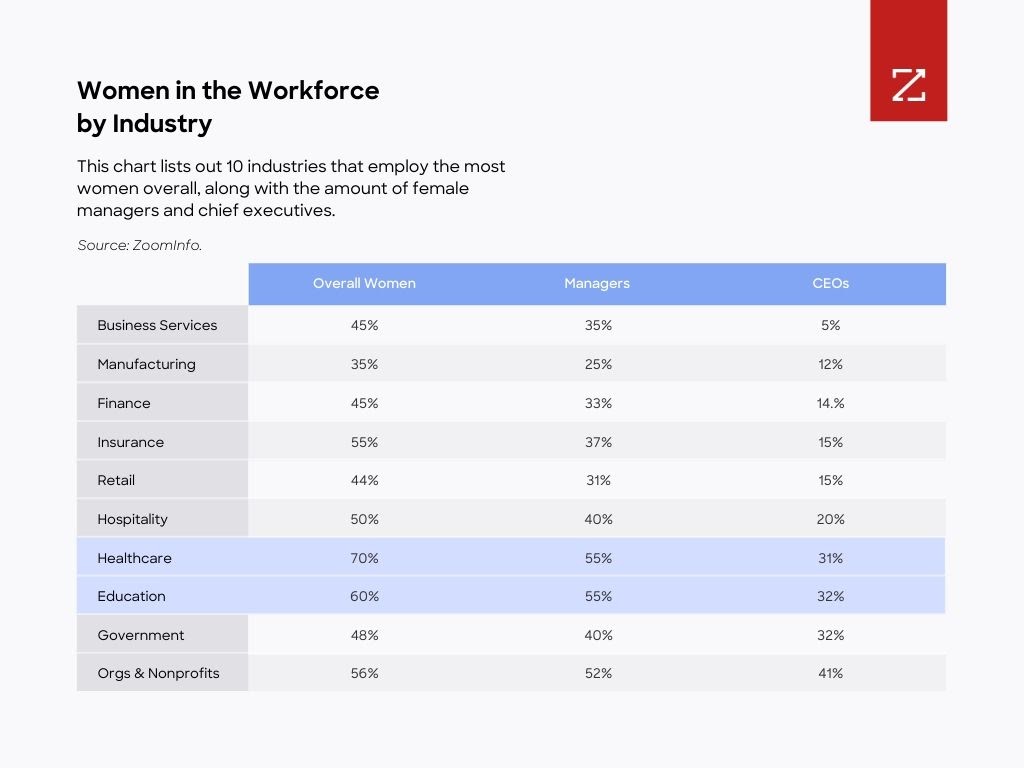
Looking at industries that employ the most women as analyzed from ZoomInfo’s database, the following industries offer the strongest options for women to be promoted to management and CEO:
Healthcare
Education
Nonprofit organizations and associations
Government agencies
All four of these industries seem to have well-rooted systems of moving women into management and then up to CEO. In other words, a healthier pipeline for promoting women.
A look at the gender breakdown in the nonprofit sector in Figure 3 shows greater parity between male and female managers, and a greater percentage of female CEOs, at least compared to other industries.
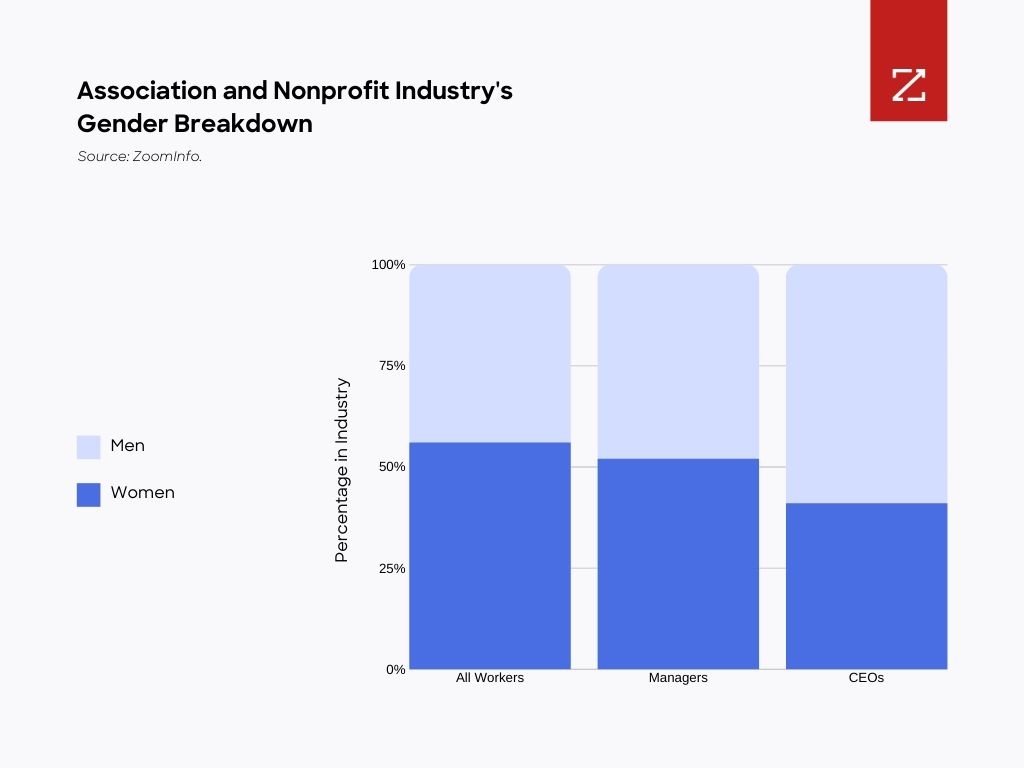
On the other end, the finance industry, where Pao was employed at Kleiner Perkins, has a much lower percentage of females in leadership positions. Although Pao lost her lawsuit against the firm, her case raised enough awareness to that similar lawsuits against gender inequality have been attributed to a “Pao effect.”
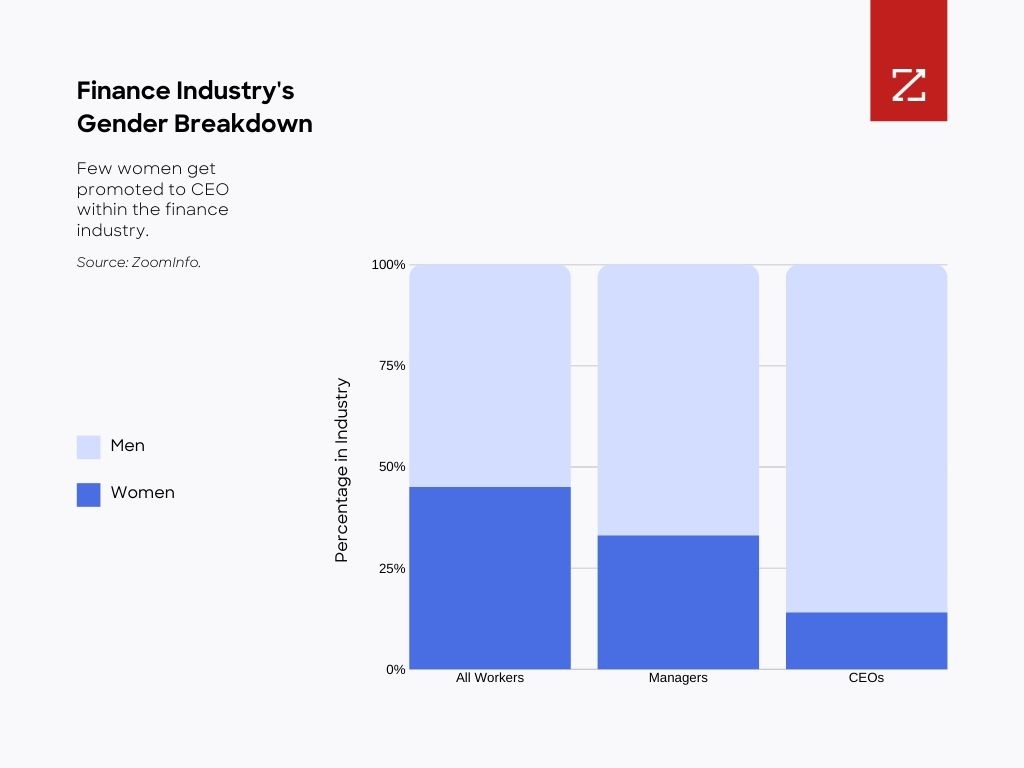
Pao wrote in her book that during her time at Kleiner Perkins, “The only path I saw to success was to work twice as hard as the men and to do the best job I could.” Unfortunately, working twice as hard was still not enough to overcome the promotion gap.
Leaving is Often the Only Option for Women
Other women in traditionally male-dominated industries have also felt the need to push harder for promotions.
Jacqueline Hinman, former CEO at construction and engineering firm, CH2M Hill, noted an incident early in her career in the 1980s when she sat down for a review at another construction company. On her paper assessment, she noted one of her goals was to be a partner at the office.
An article in Briefings Magazine (a publication of consulting firm Korn Ferry) notes, “[Her] manager, who she believes was well intentioned, said there was no doubt she had the prowess. But this office was never going to have a female partner in her lifetime. So he passed a bottle of correction fluid across the desk and told the eager employee to write something that didn’t make her look naive.”
Hinman started looking for a new job the next day. After an initial stint at CH2M, she became senior vice president of global facilities at Tyco’s Earth Tech division, before returning to CH2M and eventually ascending to CEO in 2013. She became one of only a few women to run a major engineering firm in the U.S., the Denver Post reported at the time. With only 16% of women reaching C-level positions in the construction industry, Jacqueline’s story is not just unique, it’s practically unheard of.

Hinman learned early on to challenge people and push for tough assignments. “I had to raise my hand and say I wanted to have all of these challenges and experiences. I had to ask for it,” Hinman told the Denver Post.
While industry is by no means the only factor contributing to the likeliness of being promoted, it’s evident that certain corporate dynamics (such as the number of employees and the revenue of a business) play a major role in women’s ability to rise to the C-suite.
More Women CEOs at Companies With Fewer Employees
Does a company’s size, either by revenue or workforce, influence how women are promoted? Yes, according to ZoomInfo’s data. But there’s an interesting dichotomy.
First, let’s look at the number of employees and the percentage of women managers. It starts lower at smaller companies, increases slightly with more workers, and then levels off around 40% at larger companies.
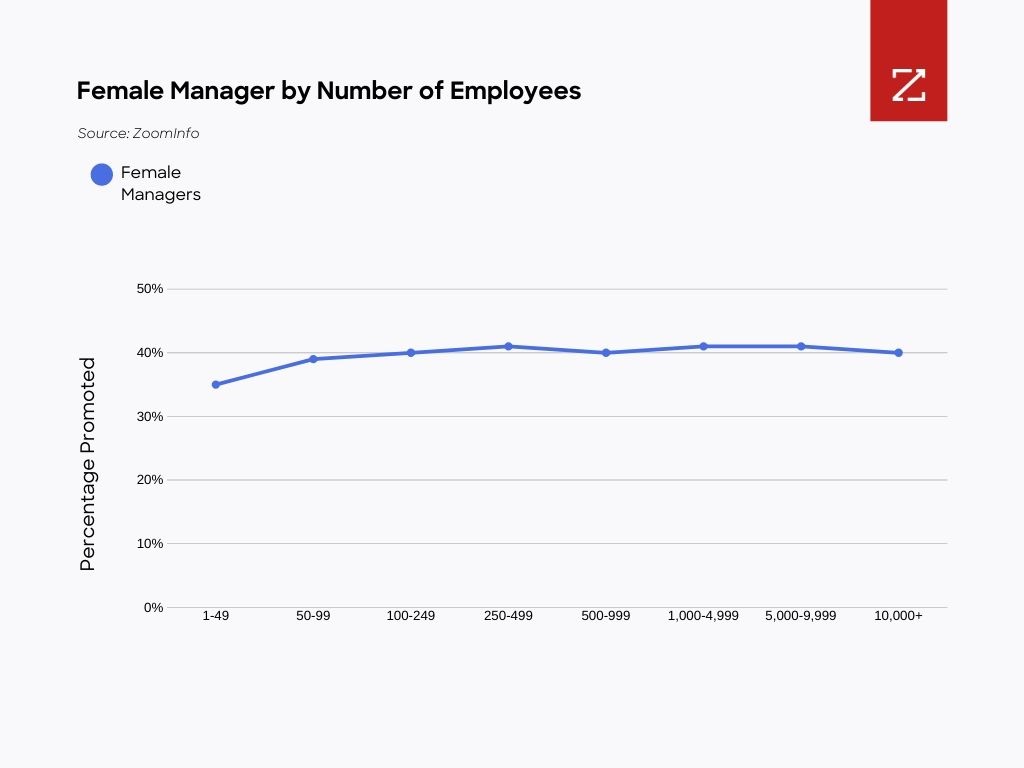
Let’s contrast that with the percentage of women CEOs. It’s higher for businesses with less than 100 workers, then drops consistently at firms with more employees. But then something unexpected happens. At large enterprises with 10,000 or more employees, the percentage of women CEOs goes up.
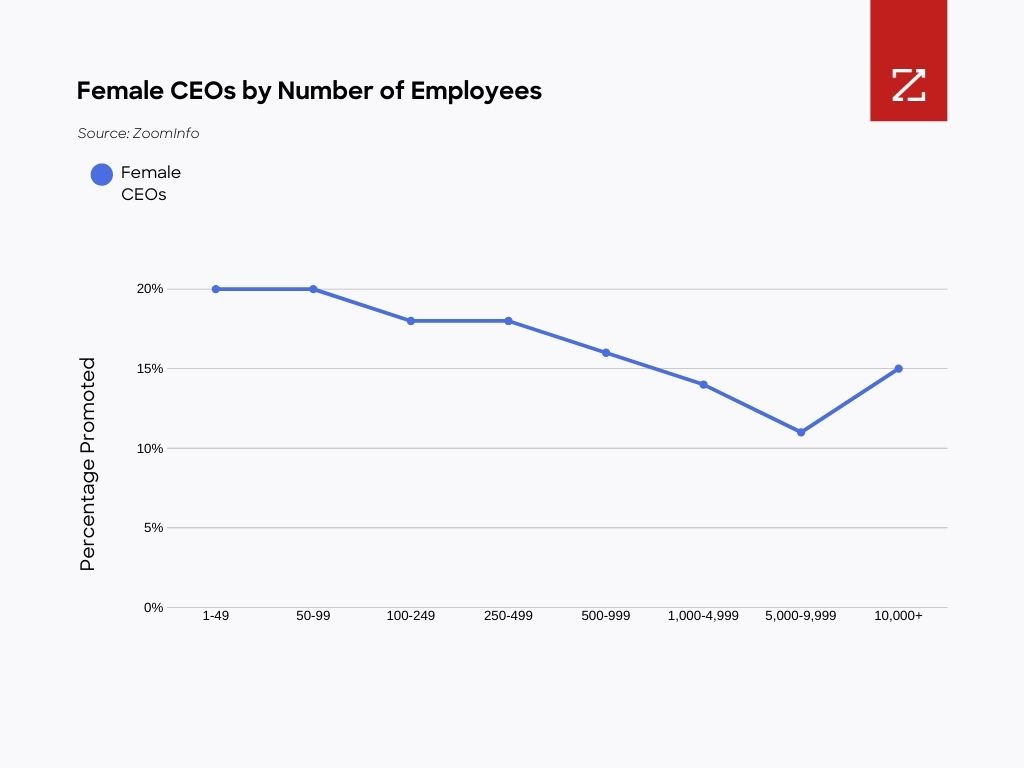
Why does this turnaround happen? One theory is that the largest companies may have more CEO slots to fill, for example, an international company with chief executives for each region. It’s also possible that enterprises are under more pressure socially to promote women.
Bump in Female Executives When Firms Earn $5 Billion or More
Looking next at company earnings, the overall number of women in companies hovers from 41% to 43% regardless of revenue. The percentage of women managers also stays relatively consistent, although there is a slight bump after companies earn more than $500 million annually.
Much like with headcount, women CEOs are more plentiful at smaller companies that pull in less than $50 million. The number of female executives decreases until an uptick at companies that have $5 billion or more in revenue.
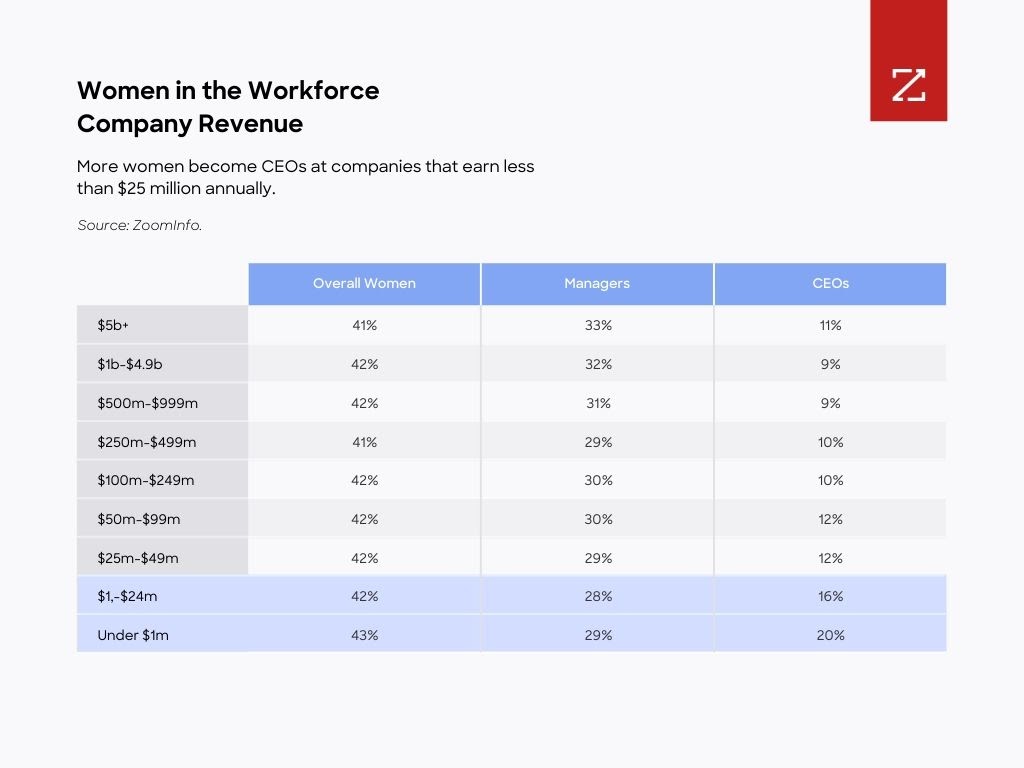
The overall conclusion is that women are more likely to get promoted to managers as firms grow, but are more likely to become CEOs at smaller companies.
Departments with More Women Fair Better
Stepping out of the C-suite, a department-by-department breakdown shows that a high percentage of women in a department often leads to a similar percentage of female managers.
For example, in human resources departments, ZoomInfo’s data indicates that 66% of the overall roster is female and 64% of all managers are women. Likewise, in marketing, 61% of the workforce is female and 57% of the managers are women.
However, operations and finance teams aren’t as balanced. In operations departments, even though 48% of the workers are women, only 35% of them become managers.
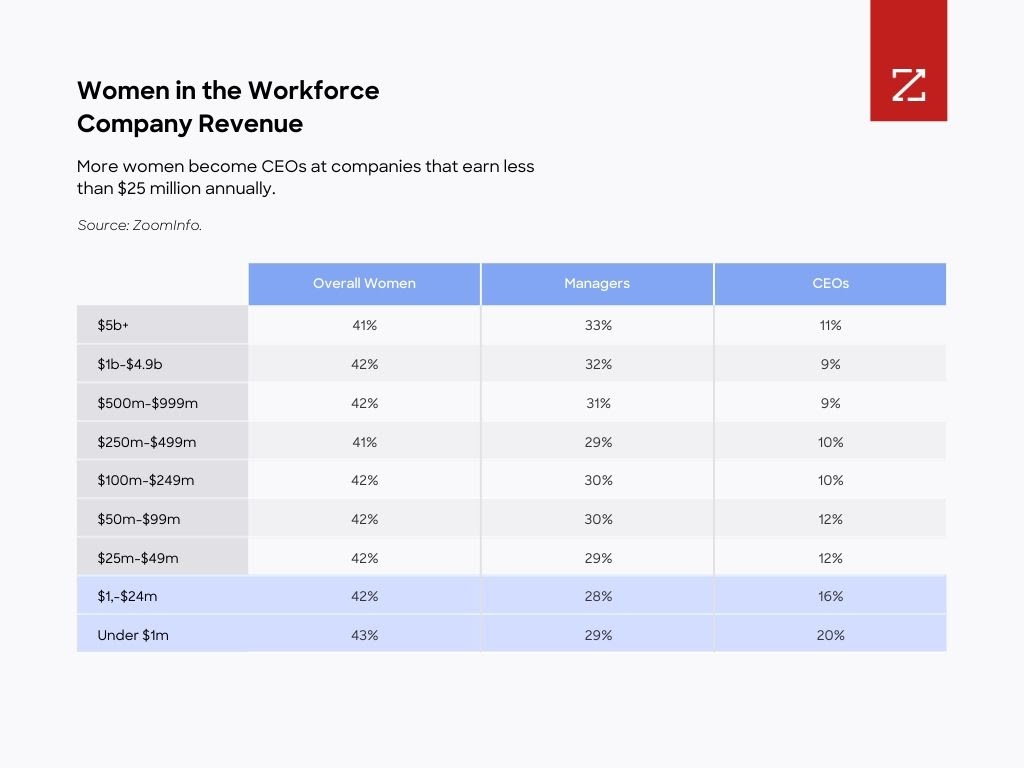
The only department that saw more women managers as a percentage than the overall female roster was engineering, with 22% women workers 23% female managers. However, those numbers may just be reflective of the lower number of women employed in engineering departments.
Outlook for Women in Manager and CEO Roles
Despite many of the numbers noted here, we are seeing positive changes for women seeking promotions. Compared to data ZoomInfo releases in 2003, many industries are improving, even though the numbers are still lower than ideal
For example, the finance industry had women in only one out of 10 CEO roles in 2007. That has increased by 40% over the last 14 years. And, the construction industry has seen an impressive jump of 71% over that same period for women chief executives.
Meanwhile, California enacted a law requiring all publicly held corporate boards headquartered in the state to have at least one female board member by December 31, 2019. Options included either filling an open board seat or adding a new seat.
